
Psst. Amazon currently has AirPods Pro headphones for $199, while Apple has them listed for $249. It’s the deal of the day for anyone looking for wireless Bluetooth earbuds, with noise-cancelling, immersive sound.

Psst. Amazon currently has AirPods Pro headphones for $199, while Apple has them listed for $249. It’s the deal of the day for anyone looking for wireless Bluetooth earbuds, with noise-cancelling, immersive sound.
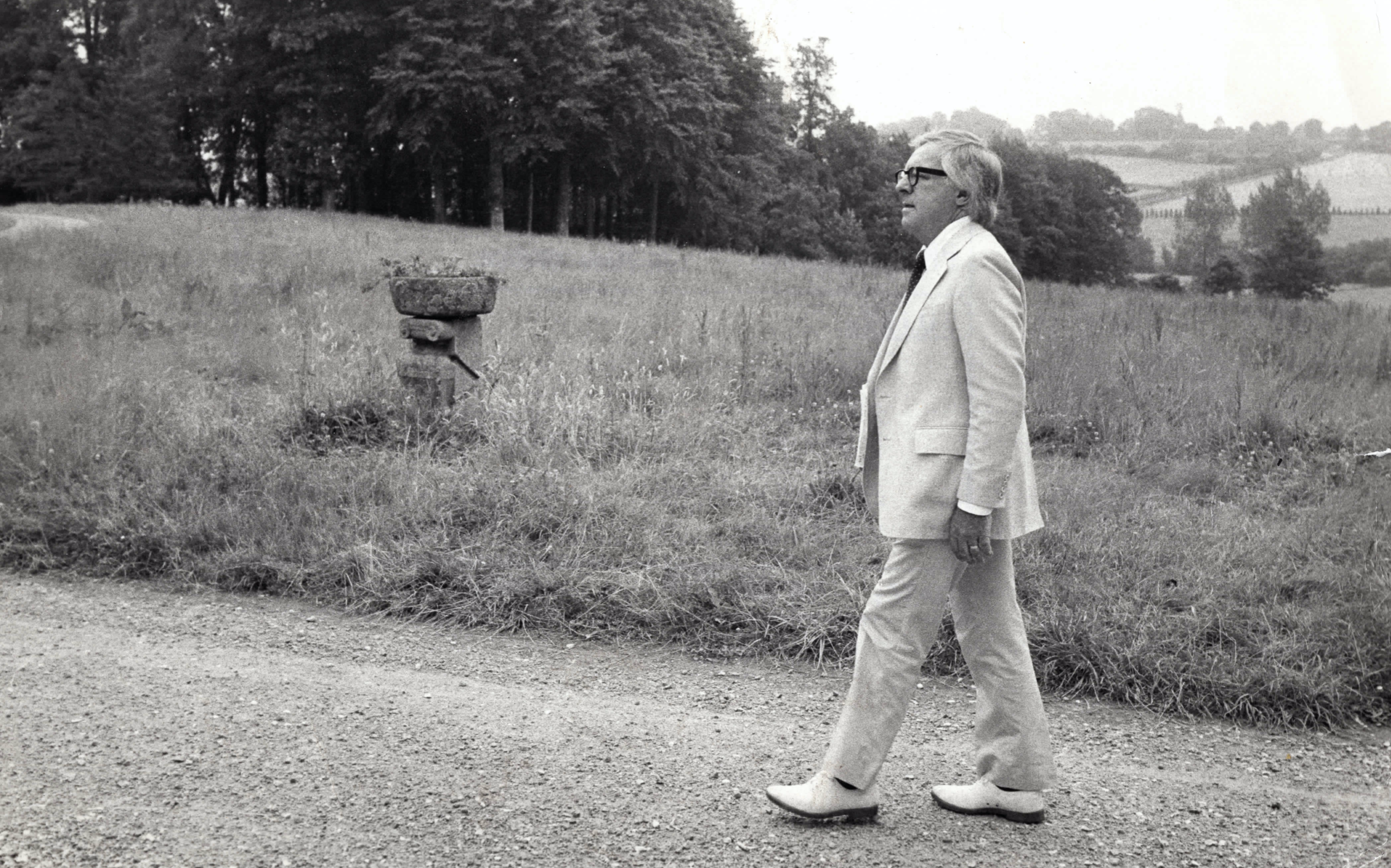
The late Ray Bradbury wrote a dizzying number of short stories over a career that spanned nine decades. Authorized Bradbury biographer Sam Weller, author of the bestselling The Bradbury Chronicles: The Life of Ray Bradbury and the indispensable companion book, Listen to the Echoes: The Ray Bradbury Interviews makes sense of Bradbury’s voluminous short story output by selecting “The Essential Bradbury,” the 25 finest tales by the beloved writer.
Bradbury wrote defiantly across genres: gothic horror, social science fiction, weird tales, fantasy, and contemporary literary fiction. He is, perhaps, best known for his 1953 chef d’oeuvre, Fahrenheit 451, but Weller (and Bradbury’s late wife of 56 years, Marguerite for that matter) argue that Bradbury’s finest work came in the form of the short story.
Weller’s “Essential Bradbury” includes some cool, never-before-seen ephemera, culled from the biographer’s personal archives. Sam Weller worked with Ray Bradbury for 12 years. You can read his “Essential Bradbury” here.
Related Content:
An Animated Ray Bradbury Explains Why It Takes Being a “Dedicated Madman” to Be a Writer
Ray Bradbury Gives 12 Pieces of Writing Advice to Young Authors (2001)
Have you ever wondered what generations hundreds or thousands of years hence will make of our strip malls, office parks, and sports arenas? Probably not much, since there probably won’t be much left. How much medium-density fibreboard is likely to remain? The colorful structures that make the modern world seem solid, the grocery shelves, fast food counters, and shiny product displays, will return to the sawdust from which they came.
Back in antiquity, on the other hand, things were built to last, even through the fires and devastation of the eruption of Mount Vesuvius in 79 AD. Archaeologists will be discovering for many more years everyday features of Pompeii that survived a historic disaster and the ordinary ravages of time. In 2019, a team fully unearthed what is known as a thermopolium, a fancy Greek word for a snack bar that “would have served hot food and drinks to locals in the city,” the BBC reports. The find was only unveiled this past Saturday.

You can see the excavation in a subtitled virtual tour at the top conducted by Massimo Osanna, Pompeii’s general director and the “mastermind,” Smithsonian writes, behind the Great Pompeii Project, a “$140 million conservation and restoration program launched in 2012.”
Richly decorated with brightly-colored paintings, preserved by ash, the Thermopolium of Regio V, as it’s known, features a scene of a nereid riding a sea-horse. Surrounding her on all sides of the counter are illustrations of the food for sale, including “two mallard ducks shown upside down, ready to be cooked and eaten,” notes the official Pompeii site, “a rooster,” and “a dog on a lead, the latter serving as a warning in the manner of the famed Cave Canem.”
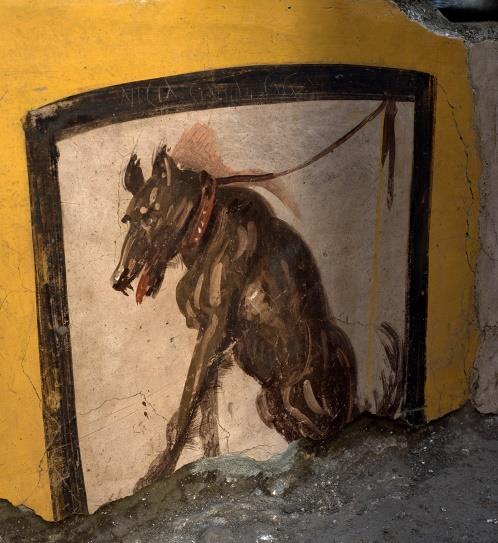
Undeterred and spurred on by the Romans’ famed love of graffiti, someone scratched a “mocking inscription” into the frame around the dog: “NICIA CINAEDE CACATOR—literally ‘Nicias (probably a freedman from Greece) Shameless Shitter!’” The message may have been left by a disgruntled worker, “who sought to poke fun at the owner.” Also found at the site were bone fragments in containers belonging to the animals pictured, as well as human bones and “various pantry and transport materials” such as amphorae, flasks, and other typical Roman containers.
Despite its elaborate design and the excitement of its discoverers, the thermopolium was nothing special in its day. Such counters were like Starbucks, “widespread in the Roman world, where it was typical to consume the prandium (the meal) outside the house. In Pompeii alone there are eighty of them.” Will future archaeologists thrill over the discovery of a Cinnabon in a thousand years’ time? We’ll never know, but somehow I doubt it. Learn much more about this discovery at the official site for Pompeii, which hopes to reopen to visitors in the Spring of 2021. All images come via Pompeiisites.org.

Related Content:
Josh Jones is a writer and musician based in Durham, NC. Follow him at @jdmagness
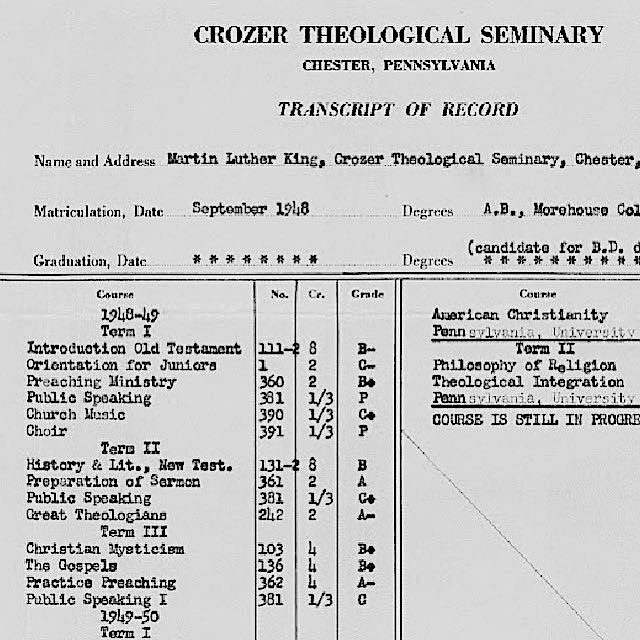
How many Americans have never heard the name of Martin Luther King Jr.? And indeed, gone more than half a century though he may be, how many Americans have never heard his voice, or can’t quote his words? Long though King will doubtless stand as an example of the English language’s greatest 20th-century orators, he once showed scant academic promise in that department. Tweeting out an image of his transcript from Crozer Theological Seminary, where King earned his Bachelor of Divinity, Harvard’s Sarah Elizabeth Lewis notes that King “received two Cs in public speaking,” and “actually went from a C+ to a C the next term.”
Still, that beat the marks King had previously received at Morehouse College. In an article for The Journal of Blacks in Higher Education, Stanford’s Clayborne Carson quotes religion professor George D. Kelsey as describing King’s record there as “short of what may be called ‘good,’ ” but also adding that King came “to realize the value of scholarship late in his college career.” This early underachievement may have been a consequence of King’s entrance into college at the young age of fifteen, which was made possible by Morehouse’s offering its entrance exam to junior high schoolers, its student body having been depleted by enlistment in the Second World War.
But King “probably realized that he would have to become more diligent in his studies if he were to succeed at the small Baptist institution in Chester, Pennsylvania, a small town southwest of Philadelphia,” writes Carson. “Evidently wishing to break with the relaxed attitude he had had toward his Morehouse studies,” he “quickly immersed himself in Crozer’s intellectual environment” and adopted a mien of high seriousness. “If I were a minute late to class, I was almost morbidly conscious of it,” King later recalled. “I had a tendency to overdress, to keep my room spotless, my shoes perfectly shined, and my clothes immaculately pressed.”
The young King eventually rose to the role in which he’d cast himself, thanks in part to the rigor of certain professors who knew what to expect from him. Apart from the sole minus blemishing his grade in “Christianity and Society,” his transcript for 1950–51 shows straight As. “By the time of his graduation,” Carson writes, “King’s intellectual confidence was reinforced by the experience of having successfully competed with white students during his Crozer years.” Named student body president and class valedictorian, “he was also accepted for doctoral study at Boston University’s School of Theology, where he would be able to work directly with the personalist theologians he had come to admire.” Even then, one suspects, King knew the real work lay ahead of him — and well outside the academy, at that.
Related Content:
How Martin Luther King, Jr. Used Nietzsche, Hegel & Kant to Overturn Segregation in America
Albert Einstein’s Grades: A Fascinating Look at His Report Cards
Based in Seoul, Colin Marshall writes and broadcasts on cities, language, and culture. His projects include the Substack newsletter Books on Cities, the book The Stateless City: a Walk through 21st-Century Los Angeles and the video series The City in Cinema. Follow him on Twitter at @colinmarshall, on Facebook, or on Instagram.
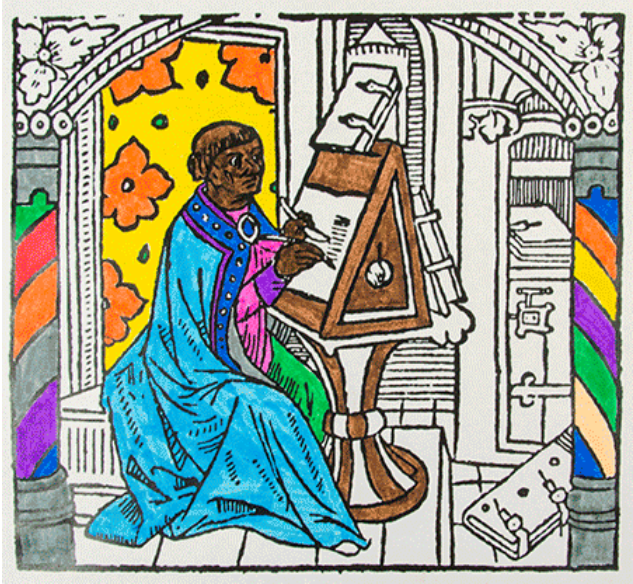
So, it’s been a year. For those of us in parts of the world where the pandemic still rages uncontained, it’s going to be an even longer winter. It may be utterly trivializing to speak of silver linings when it comes to clouds this size, but there’s no reason not to use our time wisely in quarantine, lockdown, cocooning, or whatever we’re calling it these days. For all of the enormous challenges, outrages, sorrows, and horrors of 2020, natural and manmade, we can be grateful for so many opportunities for personal growth.
“Those of us who are not sick, are not frontline workers, and are not dealing with other economic or housing difficulties” Rebecca Solnit writes, are given the task “to understand this moment, what it might require of us, and what it might make possible.” It is a moment, she says (echoing Heidegger’s ruminations on life after the dropping of the atomic bombs), in which “the impossible has already happened.”
Impossibles can be catastrophic and world changing disasters that “begin suddenly and never really end.” They can also be radical responses to disaster that open up possibilities we never imagined:
A disaster (which originally meant “ill-starred”, or “under a bad star”) changes the world and our view of it. Our focus shifts, and what matters shifts. What is weak breaks under new pressure, what is strong holds, and what was hidden emerges. Change is not only possible, we are swept away by it. We ourselves change as our priorities shift, as intensified awareness of mortality makes us wake up to our own lives and the preciousness of life. Even our definition of “we” might change as we are separated from schoolmates or co-workers, sharing this new reality with strangers. Our sense of self generally comes from the world around us, and right now, we are finding another version of who we are.
It is no exaggeration to say we have collectively witnessed the world change in a matter of a few months. Since Solnit wrote in April, we’ve had many more opportunities to meet circumstances wildly beyond our control. We are shaped by events, but how we respond, individually and together, also determines the kind of people we become.
We at Open Culture like to think we’ve contributed in some small way to our readers’ personal growth in the time of coronavirus, to their view of the world and their sense of who “we” are. Our readers responded most to messages of hope, resources for self-improvement and self-understanding, and cultural phenomena that have become sources of delight and inspiration no matter what’s going on. See our 15 top posts of 2020 below.
Let us know in the comments what other posts that didn’t make the list resonated with you in this time of sweeping change, and why. Perhaps it’s one more cosmic irony that the nightmarish year of 2020 also happens to be the number we use to symbolize perfect hindsight. But also tell us, readers, what did you learn this year, and how did you grow and change in ways you might have thought impossible a year ago?
Related Content:
The 150 Best Podcasts to Enrich Your Mind
1,500 Free Online Courses from Top Universities
Sign Up for Open Culture’s Free Daily Email
Josh Jones is a writer and musician based in Durham, NC. Follow him at @jdmagness.

What explains the immense quarantine-time popularity in America of this quaint British reality cooking show? What do we get out of watching talented amateurs bake things? Stephen Carlile, who is famous for playing Scar in The Lion King on Broadway (and is VERY British himself), joins your hosts Erica Spyres, Brian Hirt, and Mark Linsenmayer to consider the format, context, and appeal of the show.
A few articles we reviewed to prepare included:
Follow Stephen on Instagram @carlile1. Visit with him online.
Hear more of this podcast at prettymuchpop.com. This episode includes bonus discussion you can access by supporting the podcast at patreon.com/prettymuchpop. This podcast is part of the Partially Examined Life podcast network.
Pretty Much Pop: A Culture Podcast is the first podcast curated by Open Culture. Browse all Pretty Much Pop posts.
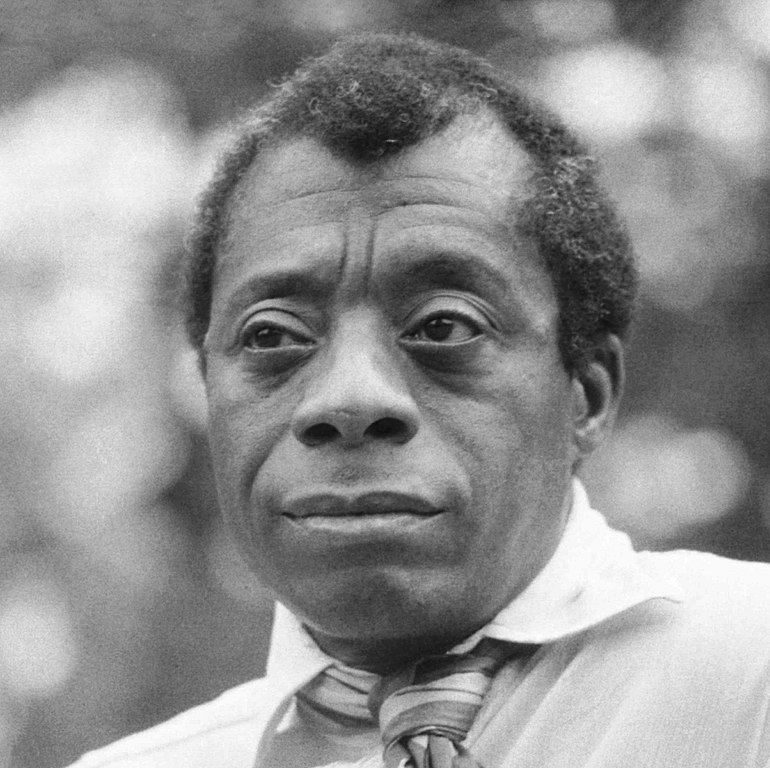
Photo via Wikimedia Commons
Each writer’s process is a personal relationship between them and the page—and the desk, room, chair, pens or pencils, typewriter or laptop, turntable, CD player, streaming audio… you get the idea. The kind of music suitable for listening to while writing (I, for one, cannot write to music with lyrics) varies so widely that it encompasses everything and nothing. Silence can be a kind of music, too, if you listen closely.
Far more interesting than trying to make general rules is to examine specific cases: to learn the music a writer hears when they compose, to divine the rhythms that animated their prose.
There are almost always clues. Favorite albums left behind in writing rooms or written about with high praise. Sometimes the music enters into the novel, becomes a character itself. In James Baldwin’s Another Country, music is a powerful procreative force:
The beat: hands, feet, tambourines, drums, pianos, laughter, curses, razor blades: the man stiffening with a laugh and a growl and a purr and the woman moistening and softening with a whisper and a sigh and a cry. The beat—in Harlem in the summertime one could almost see it, shaking above the pavements and the roof.
Baldwin finished his first novel, 1953’s Go Tell It on the Mountain, not in Harlem but in the Swiss Alps, where he moved “with two Bessie Smith records and a typewriter under his arm,” writes Valentina Di Liscia at Hyperallergic. He “largely attributes” the novel “to Smith’s bluesy intonations.” As he told Studs Terkel in 1961, “Bessie had the beat. In that icy wilderness, as far removed from Harlem as anything you can imagine, with Bessie and me… I began…”
Ikechúkwú Onyewuenyi, a curator at the Hammer Museum in Los Angeles, has gone much further, digging through all the deep cuts in Baldwin’s collection while living in Provence and trying to recapture the atmosphere of Baldwin’s home, “those boisterous and tender convos when guests like Nina Simone, Stevie Wonder… Maya Angelou, Toni Morrison” stopped by for dinner and debates. He first encountered the records in a photograph posted by La Maison Baldwin, the organization that preserves his house in Saint-Paul de Vence in the South of France. “I latched onto his records, their sonic ambience,” Onyewuenyi says.
“In addition to reading the books and essays” that Baldwin wrote while living in France, Onyewuenyi discovered “listening to the records was something that could transport me there.” He has compiled Baldwin’s collection into a 478-track, 32-hour Spotify playlist, Chez Baldwin. Only two records couldn’t be found on the streaming platform, Lou Rawls’ When the Night Comes (1983) and Ray Charles’s Sweet & Sour Tears (1964). Listen to the full playlist above, preferably while reading Baldwin, or composing your own works of prose, verse, drama, and email.
“The playlist is a balm of sorts when one is writing,” Onyewuenyi told Hyperallergic. “Baldwin referred to his office as a ‘torture chamber.’ We’ve all encountered those moments of writers’ block, where the process of putting pen to paper feels like bloodletting. That process of torture for Baldwin was negotiated with these records.”
via Hyperallergic
Related Content:
The Best Music to Write By: Give Us Your Recommendations
The Best Music to Write By, Part II: Your Favorites Brought Together in a Special Playlist
Josh Jones is a writer and musician based in Durham, NC. Follow him at @jdmagness.

Photo via Wikimedia Commons
“You do not really understand something unless you can explain it to your grandmother,” goes a well-known quote attributed variously to Albert Einstein, Richard Feynman, and Ernest Rutherford. No matter who said it, “the sentiment… rings true,” writes Michelle Lavery, “for researchers in all disciplines from particle physics to ecopsychology.” As Feynman discovered during his many years of teaching, it could be “the motto of all professional communicators,” The Guardian’s Russell Grossman writes, “and especially those who earn a living communicating the tricky business of science.”
Einstein became one of the world’s great science communicators by choice, not necessity, and found ways to explain his complex theories to children and the elderly alike. But perhaps, if he’d had his way, he would rather have avoided words altogether, and preferred acrobatic feats of silent daring to get his message across. We might at least conclude so from his reverence for the work of Charlie Chaplin. Chaplin was the only person Einstein wanted to meet in California during his second, 1930–31 visit to the U.S., when he was “at the height of his fame,” notes Claire Cock-Starkey at Mental Floss, “with newspapers tracking his every move and academics clamoring for explanations of his theories.”
The admiration, of course, was mutual. Their first meetings happened outside the press’s scrutiny, at Universal Studios, “where the pair took a tour and had lunch together. They hit it off straight away, sharing quick wits and curious minds.” In his autobiography, Chaplin writes that Einstein’s wife Elsa finagled an invitation to dinner at Chaplin’s house. And he “was only too happy to oblige,” Cock-Starkey writes, arranging an “intimate dinner, at which Elsa regaled him with the story of when Einstein came up with his world-changing theory, sometime around 1915.”
The two continued to correspond, and the big public unveiling of their friendship came when Chaplin invited Einstein to the premier of City Lights in 1931 (see photo up top) where the mega-celebrities from very different worlds were greeted by reporters, photographers, and adoring crowds. There are several recorded versions of their conversation. In one account, Einstein expressed bemusement at the cheering, and Chaplin remarked, “the people applaud me because everyone understands me, and they applaud you because no one understands you.”
Chaplin himself wrote in his 1933–34 travelogue, A Comedian Sees the World, that one of Einstein’s sons uttered the line, weeks afterward: “You are popular [because] you are understood by the masses. On the other hand, the professor’s popularity with the masses is because he is not understood.” Yet another version, circulating on the Nobel Prize’s Instagram and collecting tens of thousands of likes, has the exchange take place in a dialogue.
Einstein: “What I most admire about your art, is your universality. You don’t say a word, yet the world understands you!”
Chaplin: “True. But your glory is even greater! The whole world admires you, even though they don’t understand a word of what you say.”
Whatever they really said to each other, it’s clear Einstein saw something in Charlie Chaplin worth emulating. Chaplin left his mark on Existentialist philosophy, lending the name of his film Modern Times to Jean-Paul Sartre and Simone de Beauvoir’s influential journal, Les Temps Modernes. He left a legacy on Beat poetry, lending the name City Lights to Lawrence Ferlinghetti’s infamous San Francisco bookstore and publisher. And it seems he also maybe had some small effect on physics, or on the most famous of physicists, who might have harbored a secret ambition to be a silent film comedian—or to communicate, at least, with the universal effectiveness of one as skilled as Charlie Chaplin, favorite of geniuses and grandmothers (and genius grandmothers) everywhere.
Related Content:
60+ Free Charlie Chaplin Films Online
Hear Albert Einstein Read “The Common Language of Science” (1941)
Josh Jones is a writer and musician based in Durham, NC. Follow him at @jdmagness
All the great movies have a few memorable scenes; Pulp Fiction is made of nothing but. More than a quarter-century ago, that film’s release turned a young video-store clerk-turned-auteur called Quentin Tarantino into a household name. Cinephiles today still argue about which is the most memorable among its scenes, and only the most contrarian could fail to consider the dance. It comes early in the film, when the hitman Vincent Vega takes his boss’ wife out to dinner, the absent kingpin having ordered him to do so. The two eat at an elaborately 1950s-themed diner and on a whim enter its twist contest. They walk off the dance floor with a trophy — as well as a couple decades’ influence on popular culture.
“The twist was made famous in the 60s,” explains choreographer Lauren Yalango-Grant in the Vanity Fair video just above. “There were a lot of variations that came out of the twist that we do see in this scene,” such as “the monkey,” “the swim,” and “the Batman,” better known as “the Batusi.”
As busted by John Tavolta and Uma Thurman, all these moves come out in an improvisational fashion, each in response to the last: “If John starts to do the Batman, then Uma’s going to ‘yes-and’ it with not only a Batman but an open palm, her own version of this move,” adds choreographer Christopher Grant. Their movements give the scene a great deal of its impact, but so does those movements’ incongruity with their expressions, which Yalango-Grant calls “the juxtaposition of their seriousness and the lack of play on their faces versus the play in their bodies.”
Though now cinematically iconic in its own right, Pulp Fiction’s dance scene pays homage to a host of older films. The most obvious is Jean-Luc Godard’s Bande à part, with what Yalango-Grant calls its “amazing dance sequence in a cafe. It’s totally out of context, of nowhere.” Never shy to admit his acts of artistic “theft,” Tarantino once complained that too few picked up this one: “Everybody thinks that I wrote this scene just to have John Travolta dancing. But the scene existed before John Travolta was cast.” The director’s intention, rather, was to pay tribute to his favorite musical sequences, which “have always been in Godard, because they just come out of nowhere. It’s so infectious, so friendly. And the fact that it’s not a musical, but he’s stopping the movie to have a musical sequence, makes it all the more sweet.”
The casting of Travolta (Tarantino’s “strong, strong, strong second choice” for Vincent Vega) proved fortuitous. The very image of the man dancing made for yet another chapter of pop culture from which the film could draw, but without his real-life dancing skills and instincts, the scene wouldn’t have been as memorable as it is. “Quentin was dead-set on both of us doing the twist, which is a very fun dance, but it’s limited in how long one wants to watch someone do the twist,” Travolta remembers on a recent appearance on The Late Late Show with James Corden. So he told the director, “When I was growing up, there were novelty dances. There were dances like the swim and the Batman and the hitchhiker and the tighten up. Maybe we should widen the spectrum on this.” Tarantino’s unwillingness to compromise his ambitions and obsessions has made him perhaps the most acclaimed filmmaker of his generation, but so has knowing when to defer to the star of Saturday Night Fever.
Related Content:
Quentin Tarantino Gives Sneak Peek of Pulp Fiction to Jon Stewart in 1994
Quentin Tarantino’s Original Wish List for the Cast of Pulp Fiction
The Music in Quentin Tarantino’s Films: Hear a 5‑Hour, 100-Song Playlist
An Analysis of Quentin Tarantino’s Films Narrated (Mostly) by Quentin Tarantino
How Anna Karina (RIP) Became the Mesmerizing Face of the French New Wave
Based in Seoul, Colin Marshall writes and broadcasts on cities, language, and culture. His projects include the Substack newsletter Books on Cities, the book The Stateless City: a Walk through 21st-Century Los Angeles and the video series The City in Cinema. Follow him on Twitter at @colinmarshall, on Facebook, or on Instagram.

Another way to pass the time while we’re snuggled in, awaiting the arrival of a vaccine: David Bowie Monopoly.
Gone are the thimble, the top hat, the old boot and other iconic game pieces you may remember from your childhood or rainy days in seaside holiday rentals.
This special edition replaces them with 6 major Bowie signifiers: a star, a skull, a Pierrot hat, a rolled up tie, a space helmet, and a lightning bolt.

Monopoly has previously catered to music fans with sets devoted to AC/DC, Beatles, Metallica and the Rolling Stones, but Bowie’s chameleonic quality and highly developed aesthetic sense ensures that this one’s ephemera will appeal to all factions of the Bowieligious, not just those with the patience for a long board game.
Forget about Boardwalk and Marvin Gardens. Instead of real estate, the perimeters of the board feature albums from Bowie’s enormous catalog.
Secure albums to begin erecting stages and stadiums that other players will have to “rent” when they roll into town.
The Chance and Community Chest decks have also undergone some ch-ch-changes. Players now draw Sound and Vision cards which have the capacity to “open doors, pull some strings or bring the stars crashing down.”

Collectors will find that this set’s paper money pairs nicely with the souvenir Metrocards from Bowie’s posthumous 2018 takeover of a New York City subway station.
The four cornerstones of Monopoly—GO, Free Parking, JAIL, and Go to Jail—remain faithful to the original, leaving some fans opining that an opportunity was missed:

When you weary of David Bowie Monopoly, you can play a couple hands of Bowie, a free downloadable card game that can be printed at home:
Each player will play David Bowie, or more accurately, a persona of David Bowie. The object of the game is to achieve the greatest legacy of any Bowie and survive the 1970’s. Legacy is judged by points earned from cutting records (flat, black, round- oh, nevermind). There is one slight problem. The Bowies are endangered by various threats, dark princes, and figures of the occult (which is in no way related to the copious amount of cocaine being inhaled by our hero). If any Bowie dies, all Bowies are dead and the game is lost.
There’s also Bowie’s appearance in the 1999 video game, Omikron: The Nomad Soul:
David Bowie Monopoly is available for purchase here.
Related Content:
David Bowie’s Rise as Ziggy Stardust Documented in a New 300-Page Photo Book
When David Bowie Launched His Own Internet Service Provider: The Rise and Fall of BowieNet (1998)
Ayun Halliday is an author, illustrator, theater maker and Chief Primatologist of the East Village Inky zine. She most recently appeared as a French Canadian bear who travels to New York City in search of food and meaning in Greg Kotis’ short film, L’Ourse. Follow her @AyunHalliday.
The last time we checked in with Germany’s own Martin Miller Session Band, they dropped a lovely cover of Pink Floyd’s Dark Side of the Moon album, one that balanced all the bits you know by heart with enough of their own identity to make it jump off your YouTube screen.
Now they’re back with a new session in the age of COVID–hence a few of them wearing masks–to run through a tight 26 minutes of 1980s songs in a medley that will have your toes a’tappin’.
Now, the selection does tend toward the rock side, but the Miller Session band are set up that way, with a solid rhythm section in drummer Felix Lehrmann and Benni Jud on bass. Lehrmann certainly played *more* drums than the minimalist Nick Mason on their Pink Floyd tribute–the YouTube comments called him out a bit too much on that–but here it’s all good. If anything some of the ‘80s hits had a bit too much programmed drums, and they liven up the experience. The special guest this time is Michal Skulski, playing sax on “Sledgehammer”.
Of course, your mileage may vary with this playlist, as there are songs here that I dearly love (“Everybody Wants to Rule the World,” “Enjoy the Silence”) and ones that I could live without (“The Final Countdown, “Eye of the Tiger”), and that’s all about taste, whether you went to high school in the 1980s, or were born during it, and your repeated exposure ad nauseum to these tunes. You might be glad about the bits they leave in, or disgruntled over the sections they leave out (Miller improvs his own solo to the Tears for Fears song, but if you ask me, that original solo by Roland Orzabal and then Neil Taylor is one of the best from that entire decade, and ‘80s pop really didn’t *have* guitar solos).
But any band that decides to have a go at “Take On Me” better have those octave jumping pipes. Miller, I’m glad to say, does, channeling his inner Ronnie Dio to do so. And Marius Leicht’s organ solo is actually an improvement on the original.
However, I must point out that the finale, Depeche Mode’s “Enjoy the Silence” is not an ‘80s song. As any Mode fan will tell you, the single came out in early 1990. (I was *there* mannn, it was a totally different decade!) Still, the Martin Miller Session Band really get into this one, breaking the song down and building it back up again for a tremendous finish.
It may not be the “ultimate” ‘80s medley, but is *an* ‘80s medley and a damn good one too.
Related Content:
How the Yamaha DX7 Digital Synthesizer Defined the Sound of 1980s Music
Ted Mills is a freelance writer on the arts who currently hosts the Notes from the Shed podcast and is the producer of KCRW’s Curious Coast. You can also follow him on Twitter at @tedmills, and/or watch his films here.